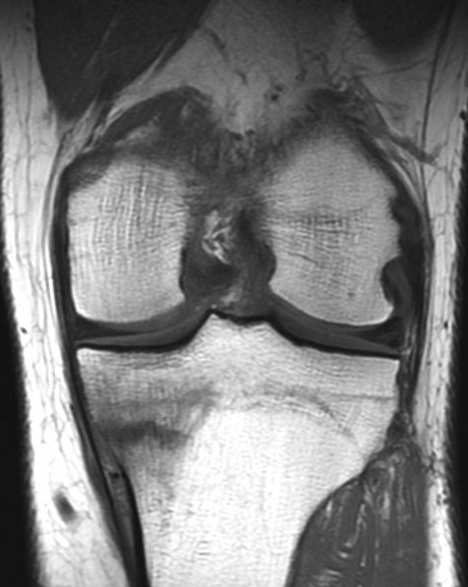Are you a runner? If so, then you’ve probably heard of a stress fracture. Stress fractures are often called hairline fractures or breaks. They are caused by overuse, are very common amongst runners, and occur most often when a runner increases the level of training or begins a new training regimen. Stress fractures commonly occur in the foot, leg and hip in runners and they usually present with insidious (gradual or subtle) onset of pain that is made worse with running or physical activity. But how do you know if you have a stress fracture, what do you do about it, and when should you get a second opinion?
As orthopaedic and sports medicine radiologists (medical doctors who specialize in diagnosing injuries and conditions using medical imaging studies), we see a lot of stress fractures on radiology exams. Why? Radiology studies (x-rays and MRI) are the tools most commonly used to detect and correctly diagnose a stress fracture.
The information you give your doctor or surgeon is vital to his or her understanding of your condition. Some questions to think about and that you may be asked are:
- What type of runner are you (for example, sprinter, short-distance runner, marathoner or long-distance runner, triathlete or someone who runs for exercise, training and conditioning or physical fitness)?
- Where is your pain?
- When did your pain start?
- Over what period did your pain develop develop? Was it a sudden onset of pain, or did it slowly develop?
- Have you had any sudden increases in activity level or abrupt change in your training regimen?
- What does your pain feel like - sharp, dull, aching, throbbing?
- How bad is your pain on a scale of 1-10? What makes it better? What makes it worse?
- Have you had any swelling or redness in the area?
Further, a physical examination performed by your doctor or surgeon is vital to his or her ability to make the correct diagnosis. He or she will examine and palpate (feel) the painful area, test your range of motion and strength and may ask you to walk. If a stress fracture is suspected by your doctor, he or she will most often begin by obtaining an x-ray to view the painful area for a possible fracture.
But are information, examination and x-ray enough to make the proper diagnosis? Often times, the answer is no.
Why? Information and examination are helpful, but do not provide a view inside the body. While x-rays do provide a view of your bones, x-rays are usually normal during the first two-to-three (2-3) weeks following onset of pain and can remain normal for considerably longer in a runner with a stress fracture. When a stress fracture does show on x-ray, its appearance will depend upon the timing and location of your injury and may not make the nature, severity, treatment or prognosis (expected outcome) of your particular stress fracture clear. Finally, x-rays only show abnormalities in bone. They will not show soft tissue injuries (such as muscle or tendon).
Are there other imaging studies that can better detect stress fractures in runners and provide a clear diagnosis?
Fortunately, there are. Your doctor or surgeon may order a CT (computed tomography) scan, nuclear-medicine bone scan, or MRI (magnetic resonance imaging) scan, depending upon your particular suspected stress fracture. MRI is considered the most sensitive and specific (most accurate) of the three tests for detecting most stress fractures and is the most commonly ordered advanced imaging study used for detecting a stress fracture that does not show up on x-rays. We will focus on MRI study for the remainder of this discussion.
MRI of Stress Fractures

MRI of Tibial Stress Fracture in Runner
MRI allows radiologists to see changes and abnormalities early on in the development of stress fractures, long before x-rays will show the fracture. Having your MRI read (interpreted) by an experienced, orthopaedic (sports-medicine) radiologist is important, because the appearance of an early stress fracture may appear similar to other conditions such as infection or bone bruise. Further, less common stress fractures or difficult-to-detect stress fractures can be overlooked by less experienced or more general radiologists. An experienced, subspecialty-trained orthopedic radiologist, with the necessary clinical information, will be able to establish the correct diagnosis and prevent further suffering and progression of injury.
Establishing the correct diagnosis will help your doctor or surgeon determine the appropriate course of treatment and prognosis for your particular injury. Of course, your doctor or surgeon can only work with the information he or she has. X-rays and MRI studies are most often read by a radiologist and a report is sent to the treating physician who then reads the report and treats the patient based upon the interpretation provided by the radiologist. If a stress fracture is overlooked or misinterpreted by the radiologist, the doctor treating you for the pain may not realize that you have a stress fracture. This can lead to improper / inadequate treatment, leading to further pain and progression of injury. Inadequate treatment and / or returning to running too soon could lead to further, more serious injury of the same area, injury of another area as you compensate for your injury, or the need for more extensive treatment such as casting or surgery. With that in mind, it’s easy to see why getting the correct diagnosis is so important.
Getting a Second Opinion
Getting a second opinion on your diagnosis may be the step you need to ensure you are getting the right treatment and have the best chance of complete healing and full return to preinjury activity levels. So when should you consider getting a second opinion?
If you’ve had an MRI or other advanced imaging study such as CT or bone scan, been given a diagnosis and / or treatment plan by your doctor or surgeon, and you answer ‘Yes’ to one or more of the following questions, you may want to consider getting a radiology second opinion:
- Do you have questions or unanswered questions about your diagnosis?
- Do you question the diagnosis you’ve been given?
- Were you told that your MRI is negative for stress fracture but you are experiencing continued pain with running?
- Do you question the severity of your injury as it’s been explained to you?
- Are you following the treatment plan that your doctor or surgeon established for you, but not getting better or seeing improvement?
- Did you rest the amount of time designated by your doctor or surgeon, yet still have pain following return to running?
- Have you been told you need a cast and want to confirm it’s really necessary?
- Have you been told you need surgery and want to confirm your diagnosis and its necessity before proceeding?
If any of these questions or concerns or others about your injury, diagnosis, treatment or prognosis arise, a radiology second opinion can give you answers, additional information and peace of mind.
Many radiology exams (x-rays and MRI) that are performed in the local community are interpreted by general radiologists who have no additional or special training in orthopedic (sports related) injuries. Our group of radiologists at NationalRad are subspecialty trained in this area and have many years of combined experience dealing specifically with the correct diagnosis of sports related injuries. Our radiologists are national leaders in the area of sports medicine imaging and have written hundreds of research articles and review articles and published entire books related to imaging of sports related injuries. Our radiologists are routinely invited to provide lectures and training for other radiologists around the country in the subspecialty area of orthopedic and sports medicine imaging. If you would like a second opinion regarding the interpretation of your x-ray or MRI, you can send your radiology study to NationalRad to get an expert second opinion. To learn more, please click here or contact us at consult@nationalrad.com.
Because running injuries, and particularly stress fractures, are on the rise, we’ll review specific stress fracture diagnoses, with a particular eye on commonly missed and high risk stress fractures, in the coming blog posts in this Running Injury series. If you’d like to learn more about stress fractures of the foot, leg and hip, due to running, stay tuned to our blog and follow us on social media.
ARE YOU READY FOR A RADIOLOGY SECOND OPINION?
CLICK HERE TO LEARN MORE & GET STARTED

